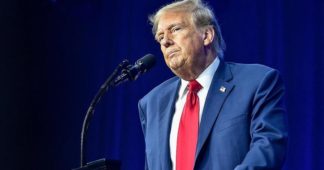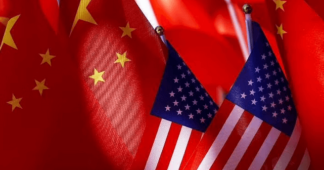By Nick Beams
4 April 2025
China has retaliated against the Trump administration’s imposition of a 34 percent “reciprocal tariff” by announcing a 34 percent tariff to be imposed on all American imports on April 10.
It has also taken other measures against the US, including an investigation into a Chinese subsidiary of the US chemical giant DuPont, further restrictions on the export of rare earths, and adding more US companies to its “entities list,” which prohibits Chinese companies from supplying them with components.
The blanket tariff on all US goods was previously considered a worst-case option, but the level of the attack was such that Beijing decided to go ahead with it.
A statement by the Chinese Commerce Ministry denounced the US action as a “typical unilateral bullying move.” It said that the US tariffs did “not comply with the rules of international trade” and seriously damaged “the legitimate rights and interests of China.”
Together with the 20 percent tariff hike announced before Trump’s so-called “liberation day” last Wednesday, the total increase in tariffs in the latest round comes to 54 percent.
But according to the Peterson Institute of International Economics, it is even higher than that. When combined with previous tariff measures, the rate comes to 76 percent—well above the 60 percent that Trump had previously threatened.
Trump responded to the Chinese action with a message on his social media that contained an implicit warning of further US action against it.
“China played it wrong,” he said. “They panicked—the one thing they cannot afford to do.”
This message needs to be read in the light of a statement in the fact sheet that accompanied the executive order announcing the tariff hikes.
It said the order, issued on the grounds of a “national security” threat, contained a “modification authority, allowing President Trump to increase the tariff if trading partners retaliate.”
The official “justification” for the “reciprocal tariffs” is that they are to compensate for non-tariff measures carried out by countries, such as taxes, regulations and biosecurity measures, deemed to be a non-market barrier to US goods.
The level of the tariff was determined in a back-of-the-envelope calculation. The trade deficit of the US with the given country was divided by the total of its exports in order to arrive at a percentage that was then halved to arrive at the “reciprocal tariff” number.
This has resulted in enormous tariff hikes for a number of Southeast Asian countries that have become significant manufacturing centers supplying the American market.
The hardest hit is Vietnam, for which the “reciprocal tariff” will be 46 percent. The tariff hit against Taiwan is 32 percent, with Thailand coming in at 37 percent.
These tariffs will have a major impact on the economies of the region, possibly pushing some of them into recession.
Whether by accident or design (the most likely explanation), the result of the cooked-up formula is indirectly aimed at China. Following the tariff measures directed at China in the first Trump administration, many companies, Chinese and American, among them, moved their operations to Southeast Asia to dodge the tariff hit. That road has now been closed.
There are now multiple warnings in the financial press and in business circles that the world is being plunged into an all-out trade war, akin to and possibly even more damaging than that of the 1930s, which played a crucial role in intensifying the Great Depression.
“This is increasingly looking like a full-blown trade war,” Guy Miller, chief market strategist at the major Swiss insurer, told the Financial Times, warning that Trump’s “misguided economic policy” had not previously been priced in by the market.
He was referring to the widely held belief that the measures would not be as severe as they were and that, in any case, they would be merely “transactional,” aimed at securing concessions within the existing regime rather than completely smashing it.
In an editorial yesterday, the FT said Trump’s decision in April would go down as “one of the greatest acts of self-harm in American history.” The “reciprocal tariffs,” it said, would “wreak untold damage on households, businesses, and financial markets across the world, upending a global economic order that America benefited from and helped to create.”
But such warnings about the effect of his measures will have no impact on Trump, for he has constructed an alternative narrative according to which the Great Depression would not have occurred had the tariffs of the era of President William McKinley been maintained and the post-war regime of liberal trade did not benefit the US but damaged it.
In another social media post directed to the “many investors” coming into the US with “massive amounts of money,” he said that “my policies will never change. This is a great time to get rich, richer than before.”
This sentiment does not seem to be shared in financial markets. Yesterday, Wall Street fell sharply again. In the two days since the tariff announcements, market capitalization has fallen by $6.6 trillion, with high-tech stocks entering bear market territory with falls greater than 20 percent.
The effects are already showing up in the real economy, with numbers of firms announcing layoffs because of the tariff hikes and the growing uncertainty.
Forecasts for US growth are being revised down. JP Morgan has slashed its forecast for growth in the US economy from a 1.3 percent year-on-year growth in the fourth quarter to a 0.3 percent contraction. It said the unemployment rate would rise to 5.3 percent.
Citigroup has cut its forecast for growth from 0.6 percent to 0.1 percent.
The massive hit on China will have ramifications around the world, not least of all in Europe, which is already under the hammer because of the 20 percent “reciprocal tariff” and the 25 percent levy on imported cars into the US.
In response, the European Union is preparing tariff measures against Chinese goods, which it considers will come into the market after being excluded from the US.
Deutsche Bank chief Germany economist Robin Winkler said the immediate trade shock to Asia would probably reverberate back to Europe, as Chinese manufacturers would try to sell more of their products as they face “a formidable tariff wall in the US.”
According to a senior US diplomat, cited by the FT:
“We will have to take safeguard measures for more of our industries. We are very concerned this will be another point of tension with China.”
One of the measures being considered is to raise the tariff on Chinese electric vehicles, now at 35 percent, even higher.
Such a response—step up the tariff war—is highly politically significant. It demonstrates that the crisis into which the world economy is being plunged is not the outcome of Trump’s irrationality. Tariff wars arise out of the fundamental contradiction of the world economy, that between globalized production and the nation-state system for which the ruling classes of every country have no answer other than a deepening war of each against all.
We remind our readers that publishing articles on our site does not mean we endorse their content. Our policy is to publish anything we find interesting, to help readers form their own opinions. We sometimes publish articles we strongly disagree with, as we believe it’s important for readers to be exposed to the widest possible range of viewpoints.











